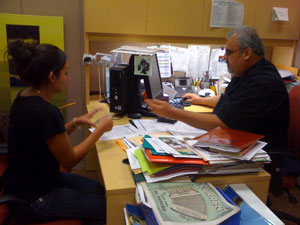
Charley Garcia, a transfer adviser in the Center for Academic Transitions, helps Denise Garza, a Biology major, prepare for her move to a four-year university. Set up an appointment to visit with one of the CAT’s advisers to save yourself time and money. Photo by Valerie O’Bar
Transferring to a four-year university is something that the majority of Palo Alto College students plan to do, and doing it right is the key to saving yourself both time and money.
The transfer process can sometimes be tricky, but with the right resources, like the Center for Academic Transitions, you will receive the help and information you need.
"Transferring is a process. It takes planning, and it can be somewhat complicated, but that is why we are here, said Katherine Beaumont, a recruiter and adviser at the Center for Academic Transitions at Palo Alto.
According to Beaumont, the key to transferring successfully is using the resources that are available, starting early and following a degree plan. One of the first things that students should do is decide on a major. Then, they should talk to the faculty advisers in that department to avoid unnecessary classes and confusion.
Joseph Pais, a Marketing/Management major and a recent transfer student from Palo Alto to Texas A&M University-San Antonio, said, "The whole transfer process is made very easy because of your adviser, so make sure you know who they are.
The next thing students should do is speak to transfer advisers at the Center for Academic Transitions from both Palo Alto and your transfer institution to get information on such things as financial aid, admissions, deadlines and degree requirements, according to Beaumont.
Students are encouraged to complete their associate’s degree before transferring to a four-year university. According to the Texas Higher Education Coordinating Board, or THECB, if a student completes the 60 hours necessary to graduate with an associate’s degree, the transferring institution is obligated to take all of those hours. However, this applies only to public universities. Private universities usually take all 60 hours, but they can pick and choose.
If you are planning to transfer to a private university, a good thing to consider is a 2+2. This joint admissions agreement is made between you and the transfer institution, and it locks you into a degree plan that will ensure a smooth transfer. The non-binding agreement also helps ensure that more of your credits transfer. To date, local private universities included in these joint agreements include St. Mary’s University, the University of the Incarnate Word, Trinity University and Our Lady of the Lake University.
Scholarships are being offered specifically to transfer students by transfer institutions. According to Danielle Espinoza, Alumni Affairs and Scholarships Coordinator in the Center for Academic Transitions, a lot of money goes untouched because students do not take the initiative to search for scholarship opportunities.
"Resources are readily available, it’s all about taking the initiative to search, said Espinoza.
The Center for Academic Transitions is located in the Student Center, Room 101, and is opened Mondays and Thursdays, 8 a.m. to 7 p.m., and Tuesdays, Wednesdays and Fridays, 8 a.m. to 5 p.m. They may be reached at (210) 486-3131.